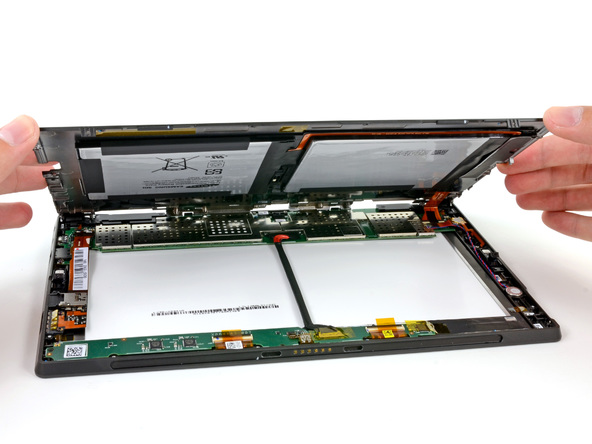Mysteries and Clues from a Microsoft Surface Teardown
Imagine you’re a surgeon who spends all day cutting up bodies and sewing them back up. Then one day, you open up a patient to find–a kidney up near the shoulder.

That extremely imprecise analogy is a little bit like what iFixit found when they tore up a Microsoft Surface. Among other things, they found a small “speaker-looking thing” next to the display in the Surface’s front case. Since there’s no direct path from the speaker-y thing to the Surface’s surface, iFixit wasn’t sure what the doohickey does exactly. Perhaps it makes the muted faux-clicking noises of the Touch Cover, they speculate.
That was just one of several curious findings in iFixit’s teardown of the Microsoft tablet. The DIY-friendly site calls the device “a quirky cat.”
Mainly, though, iFixit wasn’t excavating in search of hidden treasure. The site’s main aim was to figure out how easy the device would be to fix on your own, if you were so inclined. The answer? Not that easy. (Though a tad easier than comparable Apple products.)
iFixit ultimately gives the device a “repairability” rating of a 4 out of 10, where 10 is super-repairable. To begin with, it’s just really difficult to get elements of the Surface apart. “You’ll have to use a heat gun and lots of patience to gain access to the glass and LCD,” iFixit writes at one point. To give you some context, the Nexus 7 and Kindle Fire scored 7’s out of 10. iFixit’s score puts Microsoft much closer to Apple’s strategy of tightly locking down their gear: the latest iPad earned a measly 2 for iFixit. In a way, the Surface’s non-DIY-friendliness is another instance of Microsoft nudging it’s way towards a more Apple-like strategy, generally (see “Beyond the Surface: Microsoft Goes Apple.”)
The fact that that Surface is not friendly to makers will only affect a small majority of us–but in a sense, that’s the larger problem. We live in a generation that is increasingly happy not to think about how our devices are made or function, a generation that is happy to think of its computing devices as magic black boxes. This is one of the ideas behind the Raspberry Pi computing device: a clear casing exposes its guts, and it compels a level of elementary understanding of how the device works in order to use it. In a sense, it’s not surprising that the Surface should be difficult to open–since by anointing an in-house tablet as a standard-bearer for the next generation of Windows software, Microsoft becomes a competitor with its longstanding hardware partners. This is an era of decreasing openness in hardware, in many senses.
Keep Reading
Most Popular
Large language models can do jaw-dropping things. But nobody knows exactly why.
And that's a problem. Figuring it out is one of the biggest scientific puzzles of our time and a crucial step towards controlling more powerful future models.
The problem with plug-in hybrids? Their drivers.
Plug-in hybrids are often sold as a transition to EVs, but new data from Europe shows we’re still underestimating the emissions they produce.
Google DeepMind’s new generative model makes Super Mario–like games from scratch
Genie learns how to control games by watching hours and hours of video. It could help train next-gen robots too.
How scientists traced a mysterious covid case back to six toilets
When wastewater surveillance turns into a hunt for a single infected individual, the ethics get tricky.
Stay connected
Get the latest updates from
MIT Technology Review
Discover special offers, top stories, upcoming events, and more.